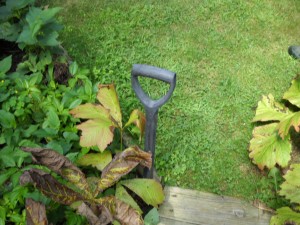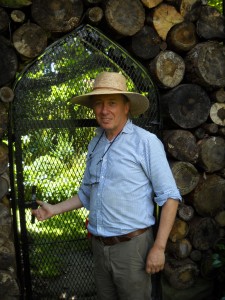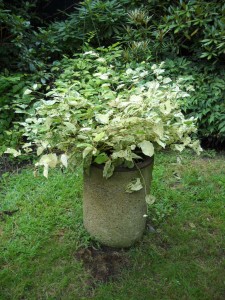Sakonett Garden and Wildmeadow
Now that I’ve put my garden to bed, I have time to think back about gardens I visited during the summer – and decide what I should try next summer. This year I had the great good fortune to spend 3 hours at Sakonnet Garden and Wildmeadow, the gardens of John Gwynne and Mike Folcarelli in Little Compton, Rhode Island. For the past 30 years they have been making and re-making gardens on about an acre of what started as a cornfield surrounding an early 1900’s Cape. They prove the point that a garden is never done: there is always something new to try.
I asked John what his garden passions have been. He said he loves playing with light in the garden: creating spaces – garden rooms – that are either bright and colorful or dark and shady. He creates special effects with plants – enclosing silver-foliaged plants with dark green hedges, for example. He enjoys showcasing dramatic plants, placing them in full sun at the end of a long dark path. He is also passionate about restoring meadows so that birds like bobolinks and meadowlarks can breed and succeed.
Like me, John is a plant collector, and one who tests plants to find which ones grow and look the best. At one point he and Mike had 500 rhododendrons, for example. They have thinned that collection down to “just” 100 or so.
As I walked through the gardens I made notes of things I might like to try, both plants and planting techniques. One of the first things I noted was their capricious use of unusual items as hose guards. Hose guards allow you to drag a 100-foot hose through the garden and go around corners without knocking over or damaging plants. They used baseball bats half buried in the soil and antique croquet wickets. I really liked their use of tool handles – old shovel handles that had snapped off – as hose guards. It is recycling at its best.
The gardens are divided up into rooms with walls, generally at least 6 feet tall. Some were made of living material –hedges or vines on trellises – and others were made from a variety of non-living materials, including stone.
One wall that caught my attention was made of logs. Logs – suitable as firewood – were simply stacked up, each piece about 2 feet long. The wall was a good 8-feet tall and made of logs that varied in diameter from an inch to six inches or more. There is a door that leads out of the room – with a gate. An iron frame that supports logs over the door; the door itself was made of flat welded iron with metal screening attached.
Training vines can be tricky, especially if you want them to travel laterally through the air. The solution they found was to roll out 25 feet or more of chicken wire, then shape it into a long roll. A three-foot width of chicken wire, when rolled up tightly, makes a form that is structurally strong enough to be suspended between trees or walls and support vines. They intermingled 2 plants: winter creeper ( Euonymus fortunei) and Japanese holly (Ilex crenata), training them to flow through the air.
John and Mike grow a number of plants that are generally considered invasive pests – things like giant hogweed (Heracleum mantegazzianum) and a variegated-leafed form of Japanese knotweed (Polygonum cuspidatum). And although I do not recommend using such plants, they have figured out ways to do so – and to contain them responsibly.
Giant hogweed grows to be 6-10 feet high and has flowers that can exceed 2-feet in diameter. They are careful to pick the flowers before they go to seed, thus preventing them from spreading. Me? I grew it before I knew better, and was able to eradicate it when I learned it can be invasive. It will grow in sun or shade, wet or dry, and has roots that go down 3 feet or more into the soil. I still watch for it, and occasionally an old seed will germinate and create another plant.
Japanese knotweed (seen along roadsides and streams and commonly called ‘bamboo’) spreads by root, so they contain it in sections of concrete well pipe – the kind that is used to contain shallow hand-dug wells. Each piece of the pipe is 30 inches in diameter and 3-4 feet long. The pipe makes a terrific planter – it is simple, sturdy, and creates a root zone deep enough for most plants, but also deep enough to contain wandering invasives.
Their garden also uses snow fence as walls for rooms. Most snow fence is 4-feet tall, but they special order 6-foot snow fence made by Griffin Fence Company in Griffin, Georgia and have it shipped to them. They support the fencing with 4-inch square posts and grow vines or hedges to make the fencing disappear, especially since they paint it black. It works well for them as deer proofing.
If you’d like to see these phenomenal gardens, John and Mike will be holding a series of open days next summer, and possibly a day of workshops next spring. Their Web site, www.sakonnetgarden.com will list the dates of their upcoming events – though the Web address may change by spring.
I will never have the time and energy to build gardens as fine as those of Mike and John, but next summer I hope try to try some of their ideas.
Henry’s Web site is www.Gardening-Guy.com.





